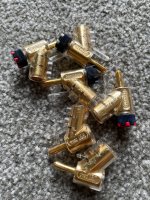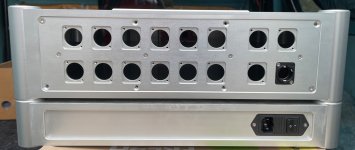The WBT connectors here are recommended in the build of the Aegis tube head amp.
https://partsconnexion.com/products/wbt-0210-cums-rca-female-jack
Anyone have experience with these connectors ? Are they worth it ? It seems many very expensive amps just use cheap Rean connectors so are those basically sonically as good ?
https://partsconnexion.com/products/wbt-0210-cums-rca-female-jack
Anyone have experience with these connectors ? Are they worth it ? It seems many very expensive amps just use cheap Rean connectors so are those basically sonically as good ?
Haven't noticed anything better than the RCA connectors that the diyAudio store sells other than the looks.
Used the silver rca next gens on a Cambridge audio 840c I modded about 12 years back. The lock rings cracked. Never bothered with them since.
I use the neutriks on the little back plates these days. Never heard a difference...
I use the neutriks on the little back plates these days. Never heard a difference...
The PDF datasheet of this WBT RCA jack are to find in post #1 underThe WBT connectors here are recommended in the build of the Aegis tube head amp.
https://partsconnexion.com/products/wbt-0210-cums-rca-female-jack
Anyone have experience with these connectors ? Are they worth it ? It seems many very expensive amps just use cheap Rean connectors so are those basically sonically as good ?
Delivery Source wanted for this Cinch female Connectors in special Outline
I am looking for the type No of WBT's predecessor version to find in the preamp device from the first both images in post #1 under
the mentioned URL.
The special feature of this WBT RCA jack was the additional solid solder lead for GND connection. This you will see if you enlarge the area around upper edge of image No 1 in post #1.
forget about sonics, look at the physical aspect...........why would you minimise the contact area?

Last edited:
I used hundreds of these WBT-0234 in my preamps, namely Musical Innovation MI 11, MI12 and MI 13. I had a few go bad, but in moving to a new platform, MI 23,xx I switched to Cardas GRFA. Better OEM price and double contacts in the same area.
And I my opinion a far better contact, with fewer parts that can break. No problems after over 300 used.
Kudos to Cardas.
R
Last edited:
No. It is stuff made to appeal and be bought on looks and belief that the setup will sound better. Male version of jewelry. Bought on emotion not by ratio.
These companies know the talk and can do the walk.
Here a picture of their superior quality. A distributor still refused to accept the fact that the plastic becomes brittle. “Can not be”. Too bad the worst ones are already discarded.
It is all business folks. Designer stuff to make you feel good. The more recent the more you will see materials that do not belong at all in connectors but when the gold shines brightly the eyes are blinded and all is good.
Besides that RCA is exactly the system one should trade for balanced. RCA by audiophile brands is riddled with pseudo science of single contact points etc. It does not matter as it is intrinsically the least optimal interface system 🙂
These companies know the talk and can do the walk.
Here a picture of their superior quality. A distributor still refused to accept the fact that the plastic becomes brittle. “Can not be”. Too bad the worst ones are already discarded.
It is all business folks. Designer stuff to make you feel good. The more recent the more you will see materials that do not belong at all in connectors but when the gold shines brightly the eyes are blinded and all is good.
Besides that RCA is exactly the system one should trade for balanced. RCA by audiophile brands is riddled with pseudo science of single contact points etc. It does not matter as it is intrinsically the least optimal interface system 🙂
Attachments
Last edited:
I don't know exactly. But I can say one thing for sure: the smaller contact surface increases the contact pressure and thus reduces the contact resistance.forget about sonics, look at the physical aspect...........why would you minimise the contact area?
View attachment 1476426
Regardless of this, there is a serious deficiency in all female RCA/cinch versions known to me:
In case of contact problems, it is impossible to determine the contact pressure of the internal female contact, even if I remove the outer part of the RCA plug so that only the center pin has to be inserted.
Unfortunately this is only possible after an additional removing of the inside front plastic insulation of the RCA plug.
Very nice!
Yeah amongst audio people the fight between XLR and RCA can be a long one. It took me many years to one day just try it as the devices to be tried out had XLR and cables were delivered with them. In hindsight is was absurd to put money, time and effort in unbalanced/RCA.
Yeah amongst audio people the fight between XLR and RCA can be a long one. It took me many years to one day just try it as the devices to be tried out had XLR and cables were delivered with them. In hindsight is was absurd to put money, time and effort in unbalanced/RCA.
The WBT NextGen are by far my favourite RCA sockets. Yes, the plastic rings crack, yes, they marry poorly with Eichmann Bulletplugs, but sound wise, still the best.
If someone has found something better sounding, less idiosyncratic and for less money, i am all ears.
If someone has found something better sounding, less idiosyncratic and for less money, i am all ears.
The best cap is no cap. The best connector is no connector. So avoiding both as much as possible is advised. No separate preamp/power amplifier for instance. Keep external pluggable connections/interfaces to a minimum.
I think many in this hobby camouflage lack of deeper knowledge or simply technical skills by putting time in items like audiophile RCA, audiophile cables, opamp rolling etc. as such actions don't ask for skills or elbow sweat and have no serious intrinsical risks.
I think many in this hobby camouflage lack of deeper knowledge or simply technical skills by putting time in items like audiophile RCA, audiophile cables, opamp rolling etc. as such actions don't ask for skills or elbow sweat and have no serious intrinsical risks.
Last edited:
That’s why my next preamp looks like this:
Nothing against XLRs, especially when used for what they are meant to transport: balanced.
Otoh, the sound of massive alu constructions is something i don't plan to inflict upon myself again in this lifetime. Let alone screwing down i/o connectors directly on to the metal.
The best cap is no cap. The best connector is no connector. So avoiding both as much as possible is advised. No separate preamp/power amplifier for instance. Keep external pluggable connections/interfaces to a minimum.
Absolutely. Unfortunately, there are sometimes practical considerations, like the ease of plugging in a commercial unit for the purposes of a reality check.
Same with amps: due to age related inability to lift very heavy boxes i have no choice but construct only mono blocks.
I still remember a report to a listening test either in the German magazine HH (Hobby HiFi) or K&T (Klang & Ton), where they investigated this and replaced every plug connection with a soldered connection (from the record player cartridge to the speaker).The best cap is no cap. The best connector is no connector. So avoiding both as much as possible is advised. No separate preamp/power amplifier for instance. Keep external pluggable connections/interfaces to a minimum.
I think many in this hobby camouflage lack of deeper knowledge or simply technical skills by putting time in items like audiophile RCA, audiophile cables, opamp rolling etc. as such actions don't ask for skills or elbow sweat and have no serious intrinsical risks.
There was talk of a drastic improvement in sound character after doing this - from my view mainly because the contact resistances of solder joints change dynamically considerably less than with plug-in transitions.
Maybe one of the member know the associated issue or at least the year of publication.
Unfortunately, the statement "best cap is no cap" is wrong, because even with offset servos (with the help of which it is apparently possible to banish all capacitors from the signal path) the two electrolytic capacitors from the symmetric power supply still remain in the symmetrical voltage supply, which unfortunately also have a strong influence on the sonic performance (not only in power amplifier devices).
Not all circuits need a servo and about all symmetric power supplies need electrolytic caps 🙂 Since having met professional audio reviewers of magazines and their modus operandi I don't believe too much of what they write as it is at least 5 out of 10 times commercially driven.
What was meant of course is the ridiculous amount of money and time some spend on supposedly magical film capacitors/RCA connectors/cables made of precious metals that can be the decisive factor of stuff sounding good or not. It is exaggerated big time just like the inverse is with regards to Wima bashing. Such persons are easily fooled in listening tests. Ideal customers for boutique brands. Also in many devices coupled to eachother both have coupling caps which is often 2 too many per stereo interface.
Anyway the less one has of (literally!) all the involved stuff the better the final result will be. Never loose focus that it is about playing back music.
What was meant of course is the ridiculous amount of money and time some spend on supposedly magical film capacitors/RCA connectors/cables made of precious metals that can be the decisive factor of stuff sounding good or not. It is exaggerated big time just like the inverse is with regards to Wima bashing. Such persons are easily fooled in listening tests. Ideal customers for boutique brands. Also in many devices coupled to eachother both have coupling caps which is often 2 too many per stereo interface.
Anyway the less one has of (literally!) all the involved stuff the better the final result will be. Never loose focus that it is about playing back music.
Last edited:
- Home
- Design & Build
- Parts
- WBT RCA connectors, worth it ?

